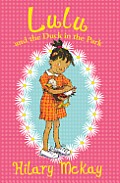Lulu and the Duck in the Park by Hillary McKay

I’ve been working on a series for younger readers all summer long and part of my work was reading a bunch of books in early middle grade fiction that are already available. This one was recommended to me by a friend. I got it from my local library. I was eager to read this one because it was very well reviewed, garnering 5 starred reviews.
Here’s what it’s about:
Lulu loves animals. When Lulu finds a duck egg that has rolled out of its nest, she takes it to class to keep it safe. Lulu isn’t allowed to bring pets to school. But she’s not really breaking the rules because it’s just an egg. Surely nothing bad will happen… A fun-filled new series for early readers and animal lovers alike.
Three Things for a Reader to Like
1. This is spot on for the tender-hearted reader. There’s enough tension but not too much. If Lulu brings another animal to school they will have to give up the beloved class guinea pig and have stick insects for a class pet instead–dreadful! And yet not dire or night mare producing.
2. Lulu is very appealing in her genuine and unabashed affection for all creatures great and small. She has a true blue best friend and a teacher who is stern enough to provide a formidable obstacle, but not so stern that she can’t also be part of the resolution.
3. I hear plenty of call for books with a non-white protagonist in which race is not the issue of the book. Well here you go! Lulu is a brown skinned girl with brown eyes and curly hair. Her best friend is of her same complexion, yet race and the usual class issues that surround such books is not an issue at all. I hope when people are making their lists of books with non-white characters that this one comes to mind.
Something to think about as a writer
So here is a “multicultural book” where the main character is clearly not white and yet in the text there is nothing at all to indicate her race, ethnicity, class, or cultural heritage. So is this cheating? Should a non-white character have something in her voice, or dress or manner of interacting with others the indicates an different point of view? I’m really not sure. I love it that Lulu is a little “every girl” and yet I wonder, is that really serving the non-white reader of the book well. I wish I had a good answer for that, but I’m not sure.
What do you think readers? Is it enough to just illustrate a character as non-white or is it important to say something about a characters background as well? I’d love to hear your thoughts in the comments.
